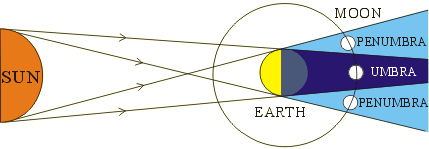A lunar eclipse occurs
Lunar Eclipse
The Earth throws a long shadow behind the side facing the Sun. A lunar eclipse occurs when the Moon enters the Earth's shadow. This shadow has two parts: the total shadow called the umbra and the partial shadow termed the penumbra (see Figure 1).
If the Moon becomes completely immersed into the umbra, a total eclipse occurs; and if only a portion of it falls into the umbra, a partial eclipse occurs.
During totality, the Moon is not completely invisible. This is due to the fact that some sunlight are refracted by the Earth's thin atmosphere into the umbra and illuminate the Moon, making it coppery-red in colour. Its brightness varies for different total eclipses depending on the geometry of the Moon's path through the umbra and also on the Earth's atmospheric conditions.
Sometimes the Moon only enters the penumbra without touching the umbra. This is a penumbral lunar eclipse. During a penumbral lunar eclipse, only the apparent brightness of the Moon will become dimmer but the limb of the Moon will not be obscured by the Earth's shadow.
